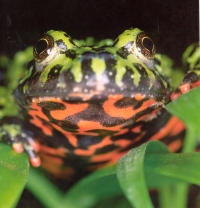| ________________
CM . . .
. Volume XI Number 11 . . . .February 4, 2005
excerpt: All frogs require water and land, but different species satisfy these needs in different ways. This is one big reason why they're so diverse. As tadpoles, many species are perfectly happy in any body of fresh water they can find, even human-made ones like cattle-watering tanks or dam basins. Other species are choosier, and depend on ponds, streams, swamps or lakes. They may also find homes in temporary pools or puddles formed by melting snow or seasonal rains. Tadpoles of many tropical species live in small pockets of water that get trapped in rain-forest plants called bromeliads. In North America, some frogs begin their lives in mud pools created by large mammals, or ponds formed by beaver dams. As adults, frogs live on the forest floor, on sand dunes, in the canopies of trees, on rocky cliffs or in caves. How do you raise concern for the welfare of a species in which some individuals may be only one centimetre long? One would think the diversity of suitable habitats should ensure their survival due to sheer numbers. Unfortunately not. In this book from "Firefly's Animal Rescue" series, the amazing facts about the dramatic decline of frogs worldwide is described. The book focuses on "habitat destruction, overharvesting by humans, competition from other species and deadly diseases" as major contributors to the demise of these amphibians that are super-sensitive to environmental disturbance. In fact, the frog has become a vital barometer of the health of our environment.
"Why Save Frogs?" asks one subtitle. As a vital link in the food chain, they provide meals for countless other animal species and, in turn, prey on harmful insects in large numbers. Some species produce chemicals that are of value for medicinal use. Check the lengthy list at the back of the book for organizations and projects whose aim is conservation and protection of frogs. Even youngsters can become directly involved through volunteer monitoring programs across the country. All that's needed, following the kindling of concern that is this book's purpose, is the will to act. Clear, high quality photos add to the interest in this well-designed book. With its up-to-date information, it would be a valuable addition to a library collection as a starting point for further investigation of this endangered amphibian. Highly Recommended. A freelance writer and former teacher-librarian, Gillian Richardson lives in BC.
To comment
on this title or this review, send mail to cm@umanitoba.ca.
Copyright © the Manitoba Library Association. Reproduction for personal
use is permitted only if this copyright notice is maintained. Any
other reproduction is prohibited without permission.
NEXT REVIEW |
TABLE OF CONTENTS FOR THIS ISSUE
- February 4, 2005.
AUTHORS |
TITLES |
MEDIA REVIEWS |
PROFILES |
BACK ISSUES |
SEARCH |
CMARCHIVE |
HOME |

 Visit a five km stretch of the Kihansi River in Tanzania, East Africa, as herpetologists learn the
Kihansi spray toad, only discovered in 1996, has virtually disappeared due to diversion of the river
by a hydroelectric dam. You'll learn how, in Costa Rica, a similar crash in the population of
golden toads was caused by a fungal disease in 1989. Poison dart frogs in Central and South
American rain forests are a target for collectors who demand high prices for these spectacularly
coloured creatures. Young readers may be amazed to know that a simple device - a water cup
formed by cutting off the bottom of a pop bottle - is being used to provide additional breeding
sites for these frogs in Peru. Not all studies of frog problems are centred in the tropics, though.
Frogs across North America are suffering severe deformities. The suspected cause: a parasite that
has increased due to modern farming practices.
Visit a five km stretch of the Kihansi River in Tanzania, East Africa, as herpetologists learn the
Kihansi spray toad, only discovered in 1996, has virtually disappeared due to diversion of the river
by a hydroelectric dam. You'll learn how, in Costa Rica, a similar crash in the population of
golden toads was caused by a fungal disease in 1989. Poison dart frogs in Central and South
American rain forests are a target for collectors who demand high prices for these spectacularly
coloured creatures. Young readers may be amazed to know that a simple device - a water cup
formed by cutting off the bottom of a pop bottle - is being used to provide additional breeding
sites for these frogs in Peru. Not all studies of frog problems are centred in the tropics, though.
Frogs across North America are suffering severe deformities. The suspected cause: a parasite that
has increased due to modern farming practices.